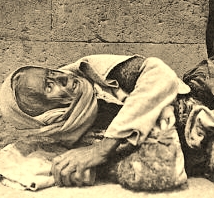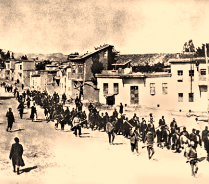Podcast: Play in new window | Download
Radio Documentary – It Was Genocide: Armenian Survivor Stories
Around the world, April 24 marks the observance of the Armenian Genocide. On that day in 1915 the Interior Minister of the Ottoman Empire ordered the arrest and hangings of Armenian intellectuals and community leaders in Constantinople. It was the beginning of a systematic and well-documented plan to eliminate the Armenians, who were Christian, and who had been under Ottoman rule and treated as second class citizens since the 15th century.
The unspeakable and gruesome nature of the killings—beheadings of groups of babies, dismemberments, mass burnings, mass drownings, use of toxic gas, lethal injections of morphine or injections with the blood of typhoid fever patients—render oral histories particularly difficult for survivors of the victims.
Why did this happen? Despite being deemed inferior to Turkish Muslims, the Armenian community had attained a prestigious position in the Ottoman Empire and the central authorities there grew apprehensive of their power and longing for a homeland. The concerted plan of deportation and extermination was effected, in large part, because World War I demanded the involvement and concern of potential allied countries. As the writer Grigoris Balakian wrote, the war provided the Turkish government “their sole opportunity, one unprecedented” to exploit the chaos of war in order to carry out their extermination plan.
As Armenians escaped to several countries, including the United States, a number came to New Britain, Connecticut in 1892 to work in the factories of what was then known as the hardware capital of the world. By 1940 nearly 3,000 Armenians lived there in a tight-knit community.
Pope Frances calls it a duty not to forget “the senseless slaughter” of an estimated one and a half million Armenians by the Ottoman Turks from 1915 to 1923. “Concealing or denying evil is like allowing a wound to keep bleeding without bandaging it,” the Pope said just two weeks before the 100th anniversary of the systematic implementation of a plan to exterminate the Armenian race.
Special thanks to Jennie Garabedian, Arthur Sheverdian, Ruth Swisher, Harry Mazadoorian, and Roxie Maljanian. Produced and written by Heidi Boghosian and Geoff Brady.
—-
Investigating Armenian-American Debanking Trend
The greater Los Angeles area is home to the largest Armenian population outside of Armenia—estimated at over 200,000 people. For years, that community has faced instances of racism and discrimination, including a rise in anti-Armenian racism, known as “Armenophobia.”
In 2022, leaked audio recordings revealed derogatory remarks by Los Angeles City Council members about Armenians, reflecting underlying biases within political institutions.
Recently, the Armenian Bar Association has launched an investigation into alleged discriminatory practices by banks in the Los Angeles area, where Armenian-American individuals and businesses have reported abrupt and unexplained closures of their bank accounts. These closures raise alarms about potential ethnic or national origin-based profiling, particularly considering ongoing geopolitical tensions in the South Caucasus.
This troubling trend comes at a time when the U.S. government is considering a major financial arrangement with Azerbaijan. The Armenian Bar Association has issued a formal objection to a proposed $100 million loan or financial guarantee to Azerbaijan under the authority of the Export-Import Bank Act of 1945. The Bar Association argues that such financial support would not only contradict U.S. human rights values but could also embolden a regime with a well-documented history of aggression against Armenia and the indigenous Armenians of Artsakh (Nagorno-Karabakh), many of whom have recently been displaced.
The Bar Association’s efforts reflect broader concerns about the security and civil rights of Armenian-Americans at home, as well as U.S. foreign policy decisions that may have far-reaching consequences abroad. arwc@armenianboard.org
Guest – Alex Hrag Bastian, a member of the ABA’s Board of Governors and Chair of its Armenian Rights Watch Committee.
—————————–




